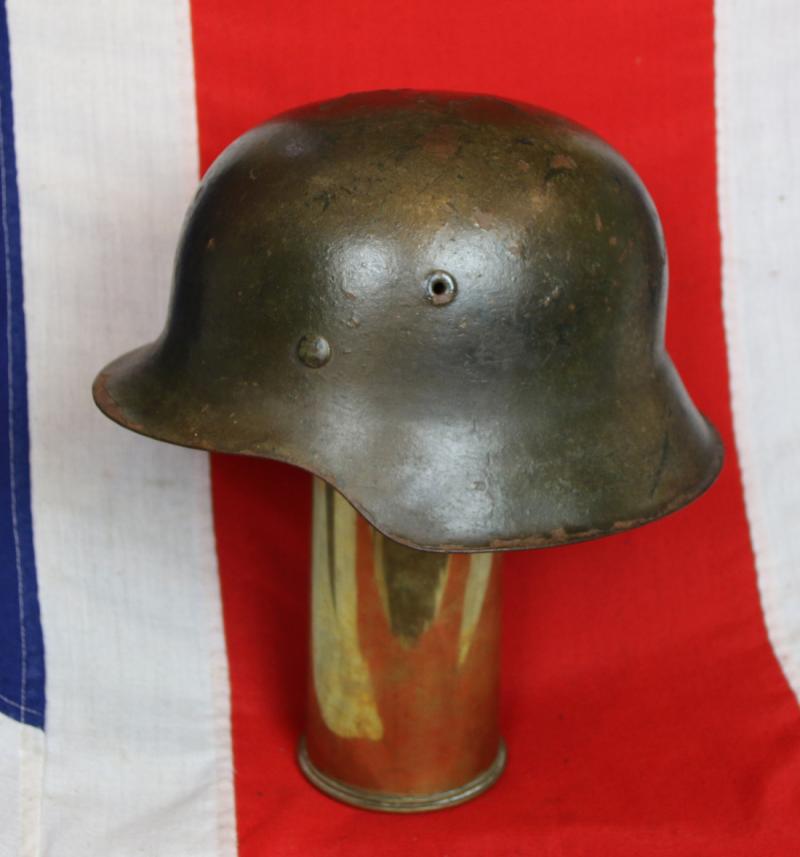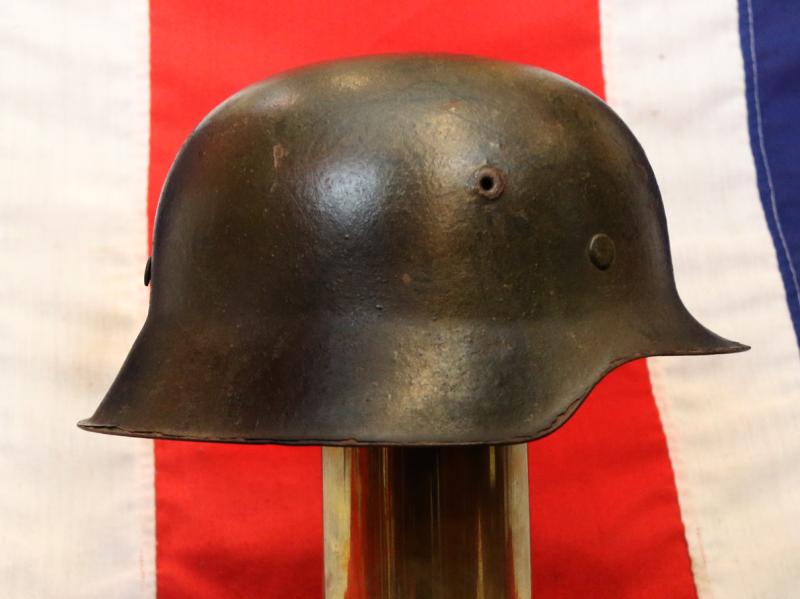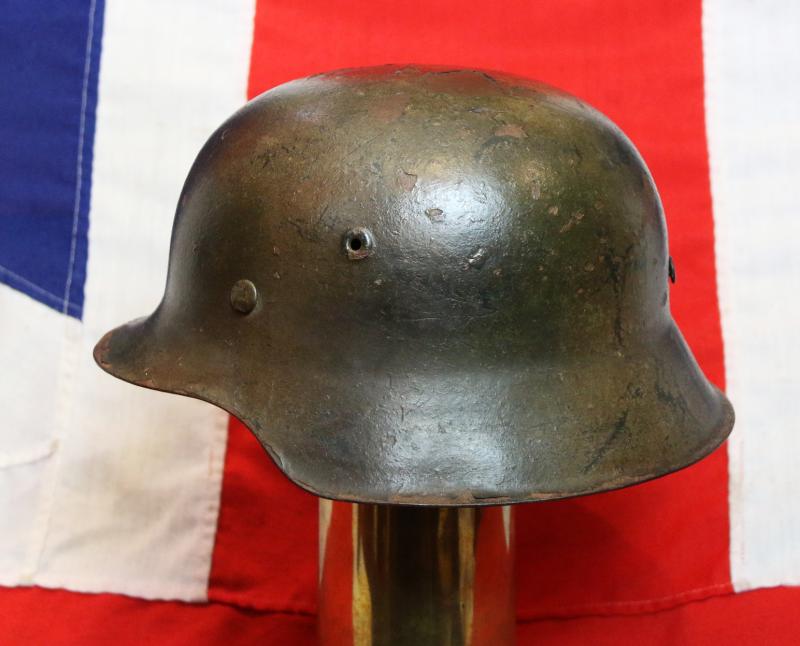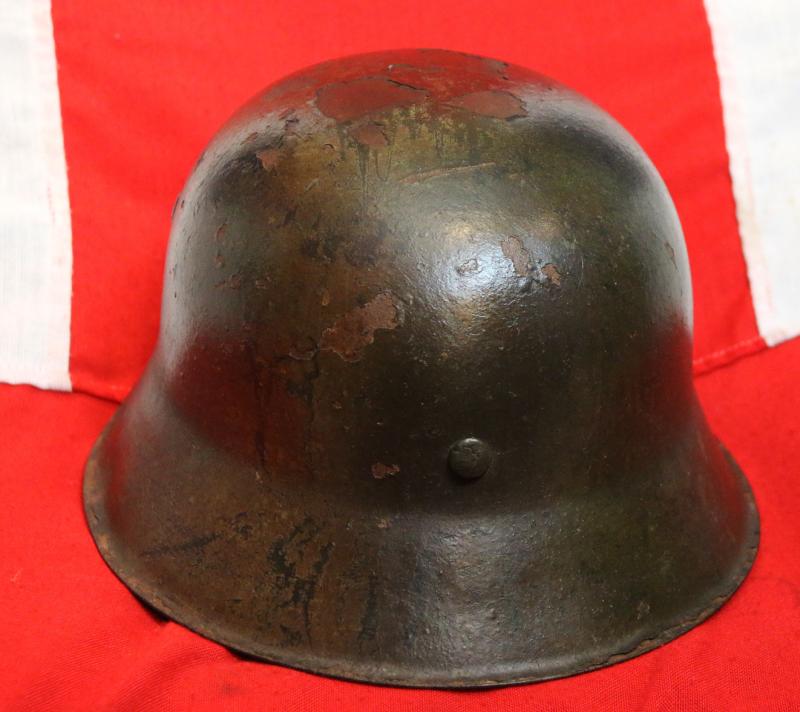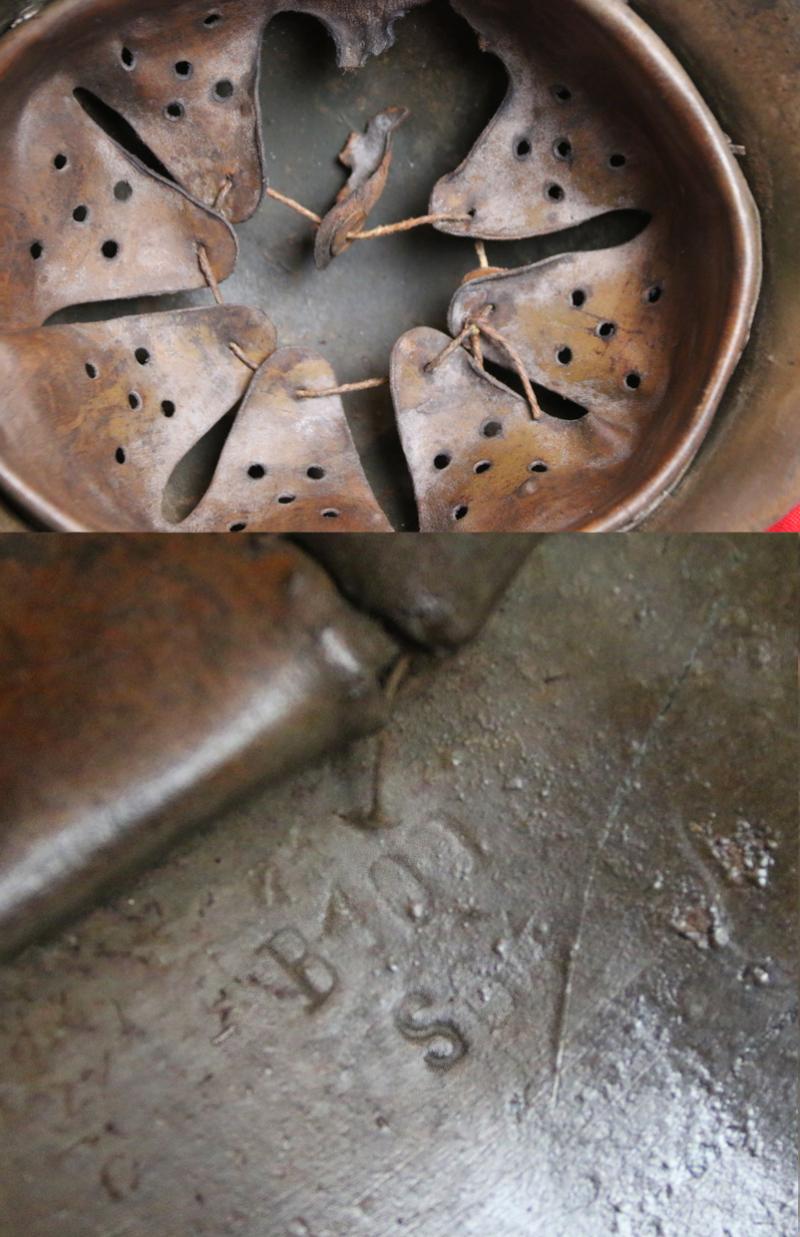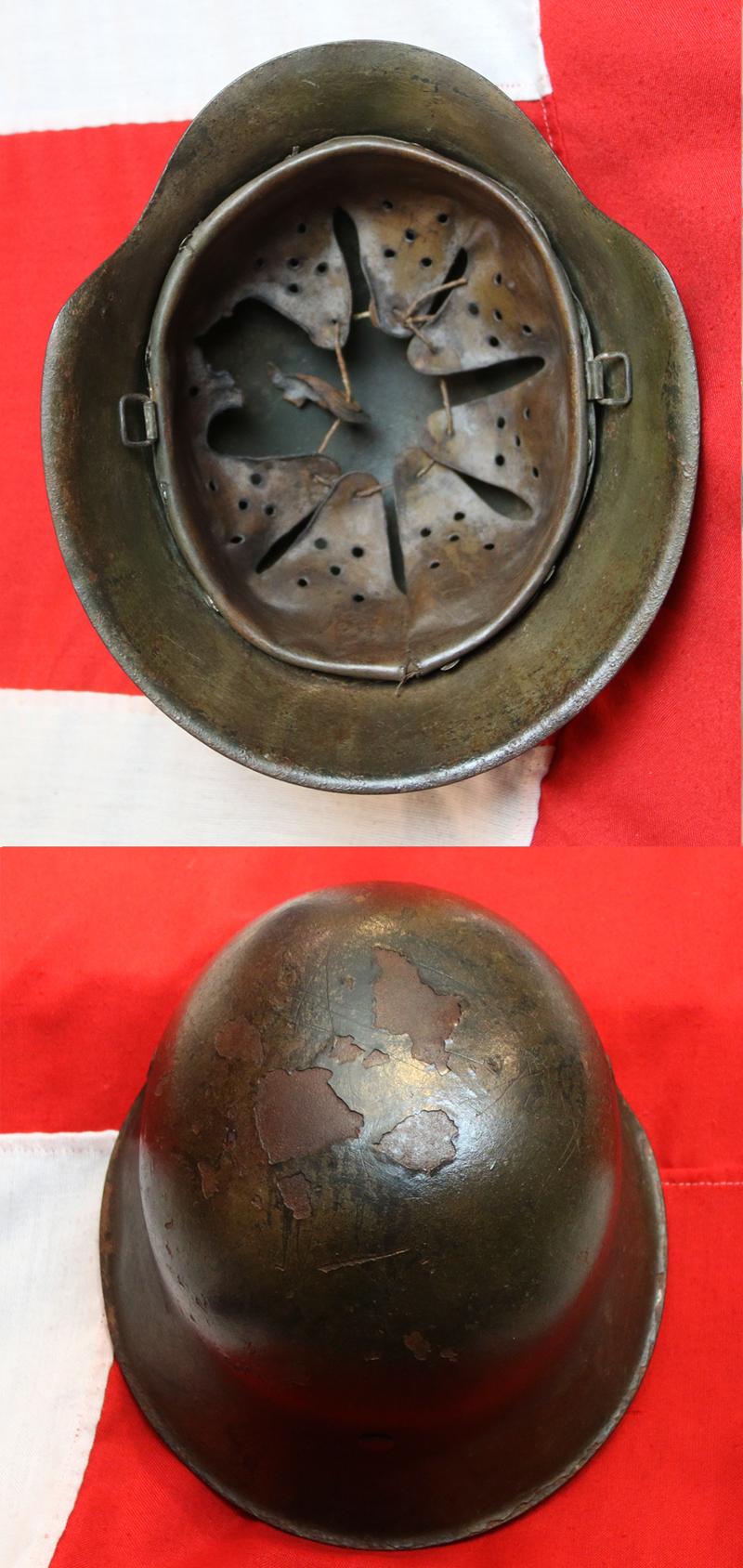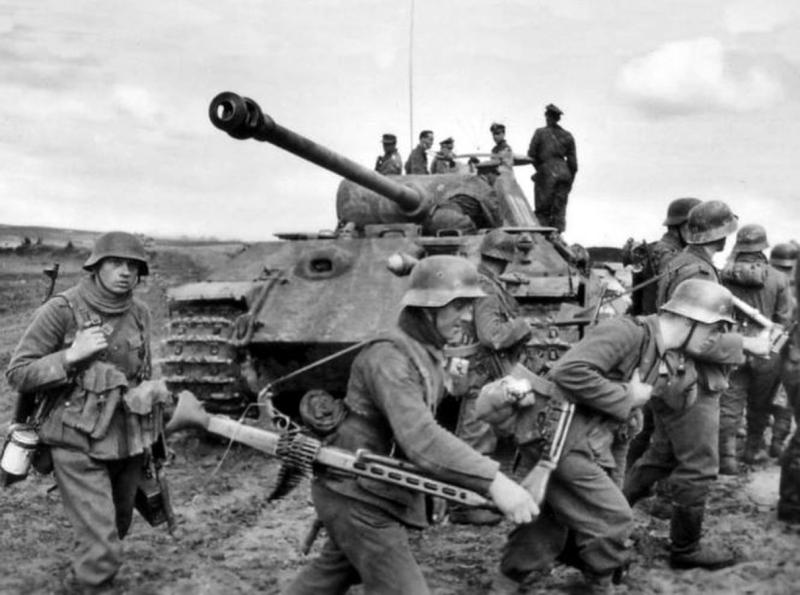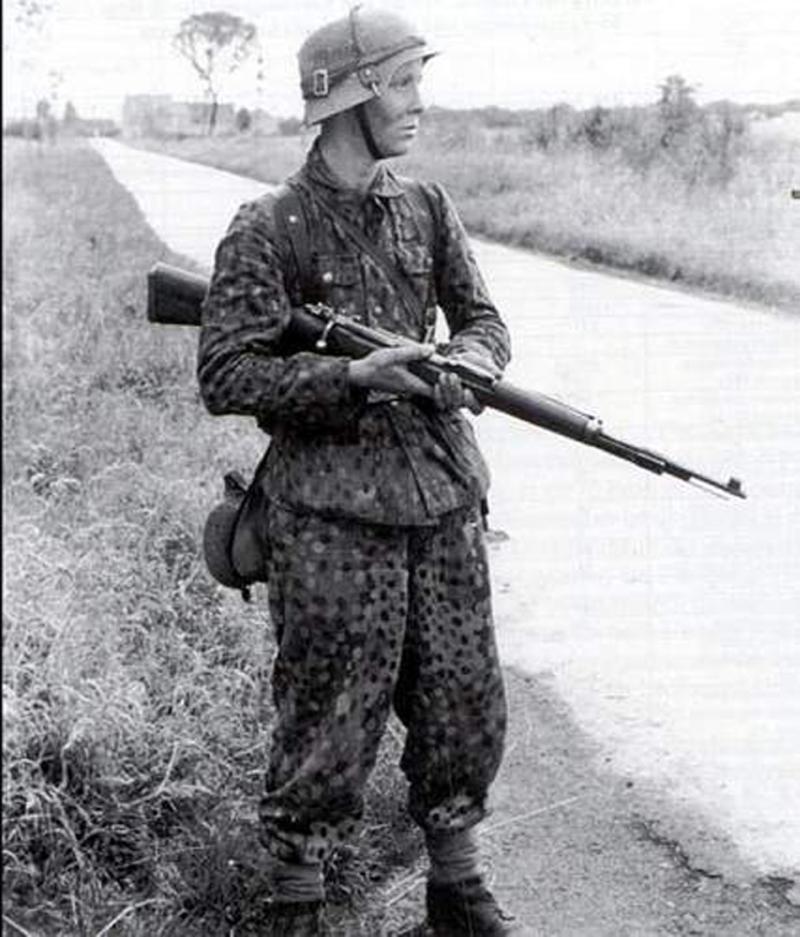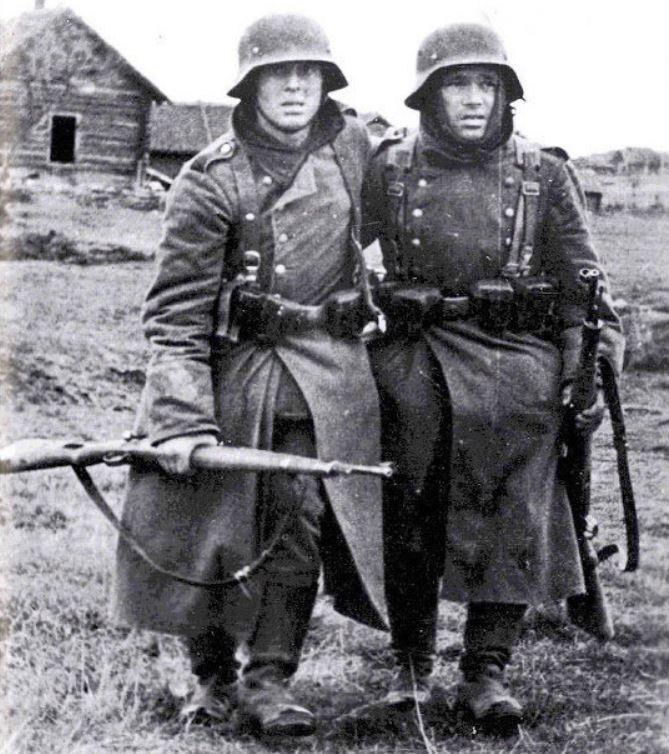A Superb M42 German Combat Helmet With Rare, Original, Classic 'Normandy Pattern' Two Colour Green , Camouflage, Original Liner & Its Three Original Perfect Liner Rivets Intact. Waffen SS/Heer Issue
Well maker stamped and numbered on the rear neck piece. SE - Sachsische Emaillerwerk, Lauteran. Later in the war their stamp mark changed to HKP. This is an absolute beauty, with obvious signs of combat service and paint wear, and losses etc., just as to be expected, but with its completely untouched original features, and it is totally 100% original, unmolested since the 1945 surrender of the Third Reich.
The German helmet of World War II is often broken down for distinction in three different models. The M35, M40 and M42. In truth according to the German high command there was only one model, the Model 35, so called because the first years of production was in 1935. The other models, the M40 and M42 do not exist in German military records. The reason for this is simply because the German military did not consider the later two versions to be new models, just modifications of the original design. The reasons for these modification were the result of a massively expanding war that required helmets as quickly as the factories could turn them out.
The German military had been experiencing helmet shortage since the 1930s. Part of this was due to the decision to sell over 220,000 brand newly produced M35 helmets to the Nationalist Chinese government between 1935 and 1937, not to mention smaller numbers of helmets being sent to Spain and Finland. The shortage was also due to the fact that the Germany military was going though massive growth during the same time frame. In addition on February 2nd of 1940 the German military ordered that all German armoured troops be issued helmets, where as before that date they were not issued one.
Starting on 28 August of 1943 an order was issued to the helmet factories that decals for the Heer, Luftwaffe, Kreigsmarine were no longer be applied. SS decals would continue to be applied at the factory level until another order was issued on 1 November 1943 requiring that the practice stop. The most likely reason the decals were dropped is likely for the exact same reason that Luftwaffe blue-gray painted helmet production ceased. The application of decals for five different branches of service was both costly and time consuming. With the war going badly the use of decals was no longer a luxury that could be afforded. By late 1944 a plane slate gray helmet would be issued to all branches of the service till the end of the war.
The panzer and panzergrenadier divisions of the Waffen SS were caught up in the strategic discussions, slowing their orders to Normandy in response to the D-Day invasion of June 6, 1944. That delay ultimately contributed to their destruction. In the meantime, however, the SS panzer and panzergrenadier divisions that did confront the Allied lodgement in Normandy in the summer of 1944 fought hard and long, impeding the advance of the British and Americans, but paying a terrible price. Once committed these divisions were true to their reputation as fierce, fanatical combat formations dedicated to Nazi ideology and men willing to die for their Führer. And die they did, thousands of them, under a relentless storm of artillery, air attacks, naval gunfire, and the thrusts of Allied ground troops toward the frontier of the Third Reich. Nevertheless, the Waffen SS exacted a heavy toll in lives and equipment while sacrificing its strength to halt the enemy in Normandy. Highly motivated and led by dedicated veteran officers, the Waffen SS soldier was deployed with the best weaponry available. From early June to late August 1944, no fewer than six Waffen SS divisions—1st SS Panzer Division Leibstandarte Adolf Hitler, 2nd SS Panzer Division Das Reich, 9th SS Panzer Division Hohenstaufen, 10th SS Panzer Division Frundsberg, 12th SS Panzer Division Hitlerjugend, and 17th SS Panzergrenadier Division Götz von Berlichingen—were joined by the 101st and 102nd SS Heavy Panzer Battalions in the death struggle.
The SS panzer divisions were equipped with tanks that had been proven superior to Allied types in tank-versus-tank combat. The 29-ton PzkPfw. IV medium tank, workhorse of the German formations, mounted a 75mm cannon, while the 45-ton PzKpfw. V Panther, perhaps the best all-around tank of World War II, was outfitted with the long-barreled high-velocity 75mm cannon, and the 56-ton PzKpfw. VI Tiger mounted a deadly 88mm high-velocity cannon.
The German guns generally possessed greater range than those of Allied tanks, and the heavier armour protection of the German armoured fighting vehicles offered enhanced survivability. The panzergrenadiers, or armoured infantrymen, were equipped with the reliable Mauser K98k bolt action rifle, squad level automatic weapons such as the MP-38 and MP-40 submachine guns, the first-generation assault rifle known as the Sturmgewehr 43, and the superb MG-34 and MG-42 machine guns, which possessed cyclical rates of fire well above those of any Allied weapon.
Roughly 100,000 German troops were trapped in the Falaise Pocket at the end of August, but 60 men of the 12th SS fought to keep the escape route open north of Argentan. After three days, four of them were captured alive. The battered Hitlerjugend and Leibstandarte fought desperately to keep the gap open, allowing up to 40,000 soldiers to elude capture. The Leibstandarte held the southern shoulder and conducted a fighting withdrawal. On the nights of August 13 and 14, the remnants of Das Reich filtered through the Leibstandarte to a new defensive line at Champosoult. On the 16th, the Leibstandarte began its final retirement as fog cloaked the withdrawal across the River Orne.
The SS divisions in Normandy were shattered, and their losses were tremendous. The Leibstandarte had suffered 5,000 casualties and abandoned nearly all its remaining tanks and artillery during the retreat at Falaise. The 9th SS Panzer Division lost half its strength, about 9,000 men, and the 10th SS Panzer had been reduced to four battalions of infantry.
Every item is accompanied with our unique, Certificate of Authenticity. Of course any certificate of authenticity, given by even the best specialist dealers, in any field, all around the world, is simply a piece of paper,…however, ours is backed up with the fact we are the largest dealers of our kind in the world, with over 100 years and four generation’s of professional trading experience behind us
Code: 25587

